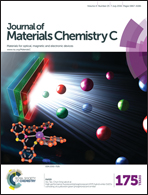Dipolar glass and magneto-electric coupling within a π-stacked organic system†
Abstract
There is much interest in the search for novel materials that show ferroelectric as well as magneto-electric coupling, such as that observed in multiferroics. Within organic based materials the electronic polarisation can originate from a charge distribution across a molecule or molecules, and so one must search for systems that have an electronic (and magnetic) dipole that is intrinsic. One such material is tetraethylammonium bis-7,7,8,8-tetracyanoquinodimethane (TEA(TCNQ)2) which is a charge transfer system with a single electron that is delocalised across a TCNQ dimer. We show that dielectric measurements yield anomalies at the cation freezing structural distortion and when singlet–triplet excitations freeze. In both cases the electric response is glassy and at low temperature the corresponding magnetic measurements evidence the strong magneto-electric coupling within the material showing scaling behaviour similar to spin glass systems.


 Please wait while we load your content...
Please wait while we load your content...